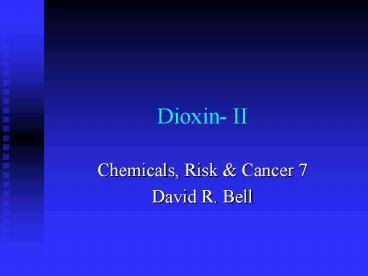Dioxin II - PowerPoint PPT Presentation
1 / 25
Title:
Dioxin II
Description:
Based on the best scientific evidence available. NOT 'safety factors' ... Study AhR -/- mice. What ... impairment and lethality Gonzalez only. Infection ? ... – PowerPoint PPT presentation
Number of Views:43
Avg rating:3.0/5.0
Title: Dioxin II
1
Dioxin- II
- Chemicals, Risk Cancer 7
- David R. Bell
2
Dioxin human toxicity
Suspected poisoning dose of 1-2 mg
2004
1998
Viktor Yuschenko Ukrainian president
26 ng/g blood fat
Normal population 20 pg/ g blood fat
144 ng/g blood fat
EHP109 865, CMAJ 172873
3
TCDD and cancer
- Dioxin reassessment
- Is TCDD a human carcinogen ?
- AhR Knockout mice- variation and use
- PAHs vs TCDD- why is there such a difference ?
AhR ancillary proteins
4
Assessment of dioxin risks-USA
- Effects of TCDD
- And related congeners (furans, PeCDD, Hex, Hept,
etc) - Human risk assessment
- Mandate
- Based on the best scientific evidence available
- NOT safety factors
5
Dioxin assessment
- http//www.epa.gov/ncea/dioxin.htm
- Previous dioxin assessment was rejected on
grounds of poor science - US regulatory policy frequently leads world
opinion - Reassessment by 2001
6
Dioxin exposure
- Total TCDD Equivalent Dose (TEQ)
- Includes TCDD and other congeners
- TCDD 10
- 1980s- 10 pg/kg/day
- 2000- 1-2 pg/kg/day
- US regulatory limit 10 fg/kg/day
- WHO/Europe 1-4 pg/kg/day
7
Dioxin exposure 2
- 1.4 ng/kg/day is the lowest dose producing
tumours in rats - But half-life of dioxin 100x longer in human
- 20 days in rats
- 2100 days in human
- TCDD accumulates to higher levels in human
- Thyroid tumours not a human problem
8
Is TCDD a human carcinogen ?
- Data for TCDD, vs other congeners, is not clear
- Animal data unequivocal
- What about human
- Requirement for highly exposed cohort of workers
- Known exposure
- Sufficient time to see a tumour response
9
TCDD as a human carcinogen
- See
- Final.pdf p.43-50
- Chapter1-6.pdf p.31-38
- Evidence of human carcinogenicity highly
controversial - Distinction between assuming it will be
carcinogenic, and whether it actually is
10
Human studies
- Confounding exposure to other carcinogens
- Smoking, industrial exposure
- Poor measurement of dose
- Measurement of serum/ adipose TCDD after the
event - What is important ?Peak dose ? Length of
exposure ?
11
Dioxin and human cancer
12
Human Results
- Increase in all tumour sites at high doses
- 1.4 fold
- Biologically non-plausible
- All known human carcinogens show site-specificity
- High doses are 100-1000 x normal background
levels of exposure
13
What does the AhR do ?
- Is there an endogenous ligand ?
- What does the endogenous ligand do ?
- AhR clears nasty foreign compounds
- Look for potential endogenous ligands ICZ.pdf
- Study AhR -/- mice
14
What does the AhR do ?
- AhR -/- mice phenotypes Science 268722-726
FujiiKO.pdf chrisKO.pdf - Small liver (all)
- Immune system impairment and lethality Gonzalez
only. Infection ? - Resistance to TCDD toxicity TCDDtoxinko.pdf
- Small liver size is due to deficient formation of
hepatic vasculature AhRshunt.pdf - Hepatic portal-venous shunting
- Defective blood vessel development
15
AhR is important
- Dioxin toxicology requires AhR
- AhR null mice are resistant to dioxin toxicity
- Liver
- Thymus
- Teratogenesis
- Nulls, congenics, etc
PNAS 10116677, JBC 27817767
16
AhR and vascular biology
- AhR null mice show defective development of the
vasculature
17
An endogenous ligand ?
- AhR hypomorphic mutants
- Low levels of the AhR
- Defective liver vascularisation in controls
- TCDD rescues !
18
PAHs vs TCDD
- Why is TCDD so much more potent than PAHs, eg
3-MC ? - In rat liver, TCDD is 30,000 x more potent than
3MC - In non-responsive mouse, no dose of 3MC induces,
whereas TCDD induces - J. Biol. Chem. 269 12118-12128
19
Binding etc
- Affinity of ligands for AhReceptor
- 0.5nM for TCDD
- 1.3 for 3MC
- 4-fold difference in competitive binding assay
- 2 hours after dosing, induction of CYP1A1 RNA
shows a 10-fold difference in potency
20
TCDD and 3MC
- 14hrs after dosing, TCDD is 1000x more potent
than 3MC at inducing AHH (CYP1A1) - AHH induction rapidly falls off after 3MC
- 3MC metabolism is rapidly induced in cells- as
early as 4 hours - Little apparent difference in AhR activation, or
DNA binding, between 3MC TCDD
21
Problems
- Why does 3MC fail to induce in the non-responsive
mouse ? - It cannot be due to hyperinduction of P450
- Does activation of the Ah Receptor act like an
on switch ? - Rapid switch off of AHH activity in 3MC treated
cells
22
AhR is a signalling molecule
- Signalling molecules should be short-lived
- Cytosolic (unbound) AhR should be long-lived
- Mol. Pharm. 49 391-398 (1996)
- TCDD induces rapid degradation of the AhR (gt90
after 4 hours) - The partner protein, arnt, is not degraded by TCDD
23
AhR turnover
- TCDD-induced AhR degradation requires functional
AhR and arnt proteins - Involves nuclear translocation of AhR, followed
by export of AhR - Degradation in the proteasome
- AhR has a short half-life when activated by TCDD
- AhRdegrad.pdf
24
AhR production is regulated
- AhR is produced in a ligand-binding conformation
in reticulocyte lysate - Inactive in bacteria, or plant cell lysate
- AIP.pdf, ara9.pdf, ara9a.pdf, ara9b.pdf
- Indentification of a protein which interacts with
AhR in yeast - Dramatic potentiation of b-NF-induced AhR
signalling by ara9/AIP in yeast
25
Role of ara9/AIP and AhR ?
- Ara9 forms a complex with AhR and hsp90
- Ara9 stabilises the functional AhRs
ligand-binding activity - Ara9 also places the AhR within the cell
- Potential for explaining how AhR translocates to
the nucleus after TCDD treatment - Production and intracellular localisation of AhR
is regulated































